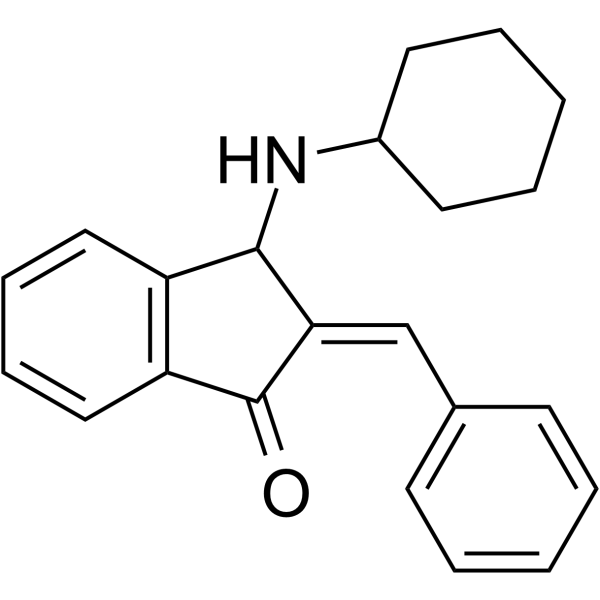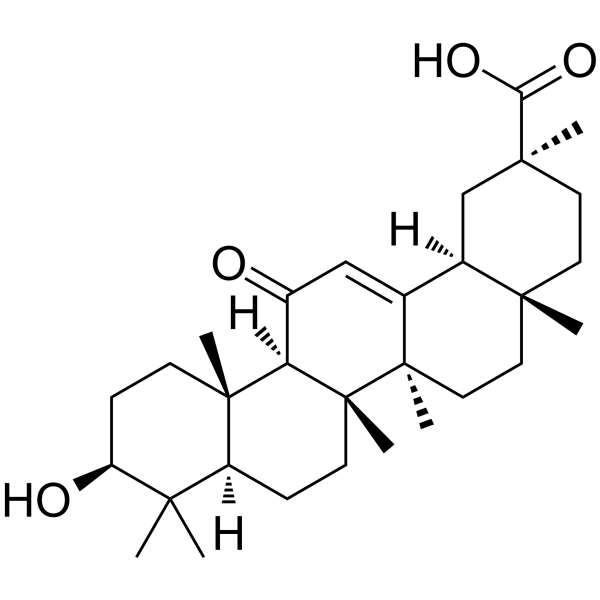|
BP10844
|
(-)-Anonaine
|
|
|
|
|
(-)-Anonaine has some anticancer activity, it induces apoptosis through Bax- and caspase-dependent pathways in human cervical cancer (HeLa) cells, it induces DNA damage and inhibits growth and migration of human lung carcinoma h1299 cells.
|
|
BP10040
|
(-)-Huperzine A
|
|
|
|
|
(-)-Huperzine A (Huperzine A) is an alkaloid isolated from Huperzia serrata, with neuroprotective activity. (-)-Huperzine A is a potent, highly specific, reversible and blood-brain barrier penetrant inhibitor of acetylcholinesterase (AChE), with an IC50 of 82 nM. (-)-Huperzine A also is non-competitive antagonist of N-methyl-D-aspartate glutamate (NMDA) receptor. (-)-Huperzine A is developed for the research of neurodegenerative diseases, including Alzheimer’s disease.
|
|
BP10700
|
(±)-Zanubrutinib
|
|
|
|
|
(±)-Zanubrutinib is a specific, potent and orally available Btk inhibitor.
|
|
BP10064
|
(6R)-FR054
|
|
|
|
|
FR054 is an inhibitor of the Hexosamine Biosynthetic Pathway (HBP) enzyme PGM3, with a remarkable anti-breast cancer effect.
|
|
BP10383
|
(E)-AG 556
|
|
|
|
|
AG 556 is a selective inhibitor of EGFR and blocks LPS-induced TNF-α production.
|
|
BP10255
|
(E)-AG 99
|
|
|
|
|
AG-99 is an inhibitor of EGFR kinase (IC50: 10 μM in the human epidermoid carcinoma cell line A431).
|
|
BP10883
|
(E)-Cardamonin
|
|
|
|
|
Cardamomin (also known as cardamonin) is a chalconoid that has been isolated from several plants including Alpinia katsumadai and Alpinia conchigera. It is a novel antagonist of hTRPA1 cation channel with an IC50 of 454 nM. It has received growing attention from the scientific community due to the expectations toward its benefits to human health.
|
|
BP10884
|
(E)-Methyl 4-coumarate
|
|
|
|
|
Methyl trans-p-Coumarat is a predicted metabolite generated by BioTransformer1 that is produced by the metabolism of methyl 3-phenylprop-2-enoate.
|
|
BP10664
|
(E/Z)-BCI
|
|
|
|
|
(E/Z)-BCI attenuates LPS-induced inflammatory mediators and ROS production in macrophage cells via activating the Nrf2 signaling axis and inhibiting the NF-κB pathway. (E/Z)-BCI is a dual-specificity phosphatase 6 (DUSP6) inhibitor with anti-inflammatory activities.
|
|
BP10375
|
(Rac)-Benpyrine
|
|
|
|
|
(Rac)-Benpyrine is a potent and orally active inhibitor of TNF-α.
|
|
BP10479
|
(Rac)-IBT6A
|
|
|
|
|
(Rac)-IBT6A is a racemate of IBT6A. IBT6A is an impurity of Ibrutinib and can be used in the synthesis of IBT6A Ibrutinib dimer and IBT6A adduct.
|
|
BP10724
|
(Rac)-PT2399
|
|
|
|
|
(Rac)-PT2399 is a potent and specific inhibitor of hypoxia-inducible factor 2a (HIF-2α)(IC50 of 0.01 μM).
|
|
BP10122
|
(Rac)-SAR131675
|
|
|
|
|
SAR131675 is an effective and specific VEGFR-3 inhibitor. It inhibited VEGFR-3 tyrosine kinase activity (IC50: 20 nmol/L) and VEGFR-3 autophosphorylation (IC50: 45 nmol/L) in HEK cells, respectively. SAR131675 is highly specific for VEGFR-3 versus 107 receptors, enzymes, ion channels, and 65 kinases. SAR131675 is a highly specific VEGFR-3-TK inhibitor with significant antitumoral and antimetastatic activities in vivo through inhibition of lymphangiogenesis and TAM invasion.
|
|
BP10836
|
(S)-(−)-Perillyl alcohol
|
|
|
|
|
(S)-( )-Perillyl alcohol, a monoterpene found in lavender, inhibits the farnesylation of Ras, upregulates the mannose-6-phosphate receptor and induces apoptosis. It also has anti-cancer activity.
|
|
BP10438
|
(S)-crizotinib
|
|
|
|
|
(S)-crizotinib(IC50 of 72 nM), an effective MTH1 (NUDT1) inhibitor, is the (S)-enantiomer of crizotinib.
|
|
BP10889
|
(Z)-Semaxinib
|
|
|
|
|
Semaxanib (SU5416) is a potent and selective VEGFR(Flk-1/KDR) inhibitor (IC50: 1.23 μM), 20-fold more selective for VEGFR over PDGFRβ, no inhibition for FGFR, InsR, and EGFR. Semaxanib is a quinolone derivative with potential antineoplastic activity.
|
|
BP10361
|
1-(4-Chloro-3-(trifluoromethyl)phenyl)-3-(4-(4-cyanophenoxy)phenyl)urea
|
|
|
|
|
SC-1 is a a derivative of the multiple tyrosine kinase inhibitor sorafenib. SC-1 potently inhibits the phosphorylation of STAT3 by blocking STAT3 phosphorylation and activation, and induces apoptosis in hepatocellular carcinoma cell lines.
|
|
BP10575
|
1,5-Dihydroxyxanthone
|
|
|
|
|
1,5-Dihydroxyxanthone exhibits the epidermal growth factor receptor (EGFR) -tyrosine kinase inhibitory activity, with the IC50 value of 90.34 nM. It may have anticholinesterase activity on acetylcholinesterase (AChE) and butyrylcholinesterase (BChE) enzymes.
|
|
BP10046
|
17-Hydroxy sprengerinin C
|
|
|
|
|
17-Hydroxy sprengerinin C is a glycoside compound isolated from rhizomes of Polygonatum sibiricum with stronger anticancer activities. 17-Hydroxy sprengerinin C reduces the expression of Blc-2 and pro-caspase3 and increases the production of Bax.
|
|
BP10552
|
18α-Glycyrrhetinic acid
|
|
|
|
|
Enoxolone (INN, BAN; also known as glycyrrhetinic acid) is a pentacyclic triterpenoid derivative of the beta-amyrin type obtained from the hydrolysis of glycyrrhizic acid, which was obtained from the herb licorice. It is used in flavoring and it masks the bitter taste of drugs like aloe and quinine. It is effective in the treatment of peptic ulcer and also has expectorant (antitussive) properties.
|
-Anonaine.gif)
-Huperzine A .gif)
-Zanubrutinib.gif)
-FR054.gif)
-AG 556.gif)
-AG 99.gif)
-Cardamonin.gif)
-Methyl 4-coumarate.gif)

-Benpyrine.gif)
-IBT6A.gif)
-PT2399.gif)
-SAR131675.gif)
-(−)-Perillyl alcohol.gif)
-crizotinib.gif)
-Semaxinib.gif)
phenyl)-3-(4-(4-cyanophenoxy)phenyl)urea.gif)



